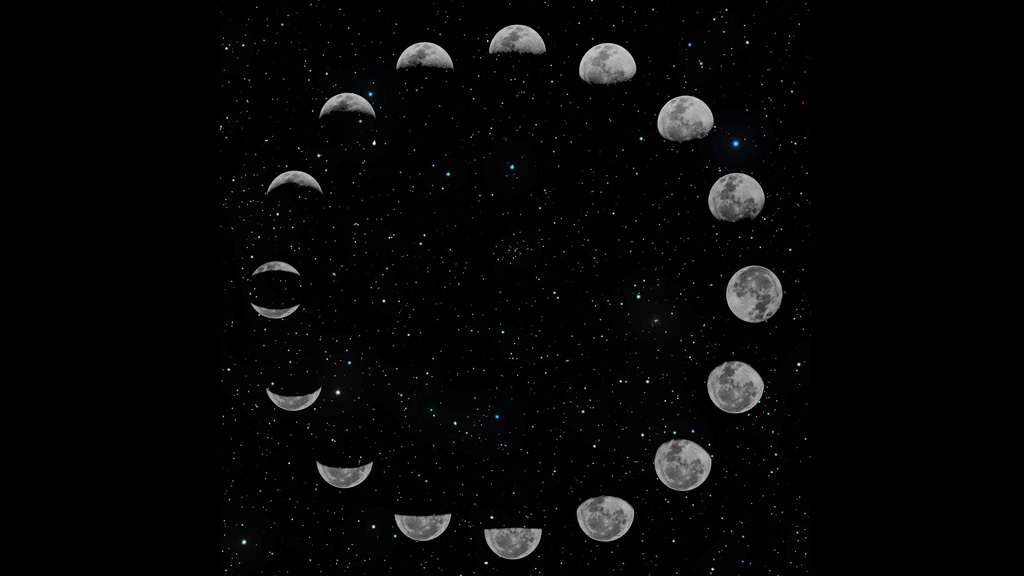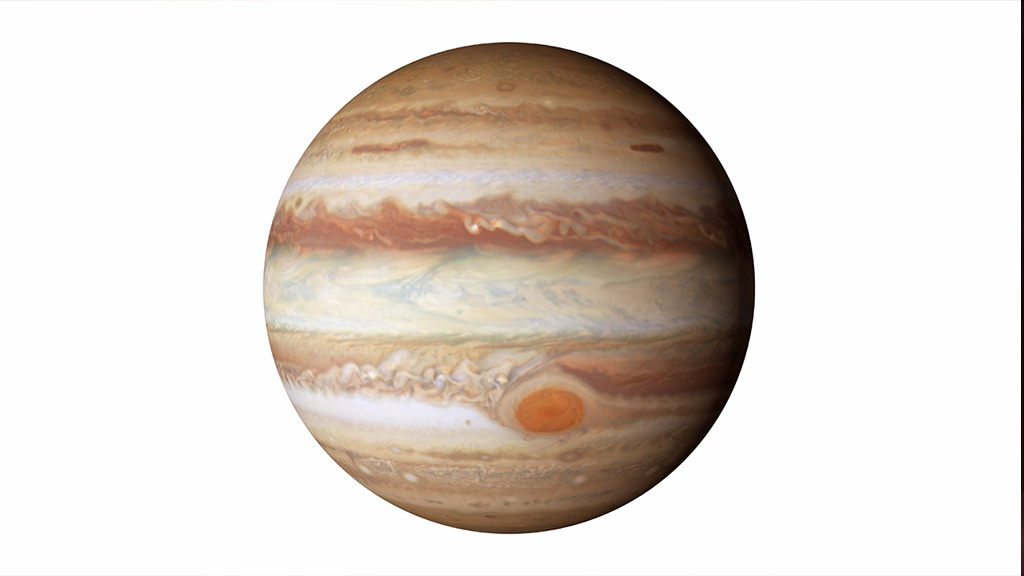The Moon
La Luna

The moon in the night sky
La luna en el cielo nocturno
English | LEVEL A

The moon in the night sky
La luna en el cielo nocturno
Most of us have neighbors. If you live in an apartment, you probably have neighbors that live close to you. If you live far from a city, your neighbors might live far away. Planets have neighbors too. The Moon is Earth’s closest neighbor in space.
Have you ever wondered about how the Moon was formed? When the Earth was very young, a giant space rock crashed into Earth. The rock was almost as big as a planet. It was a huge smash! Pieces of Earth and the rock flew into space. Those pieces started spinning around Earth. Slowly they came together to form the moon. So, the moon is kind of like a big space puzzle made from parts of Earth and that rock.
The moon is a big, round rock. It orbits, or circles, Earth. The Moon is not a planet. It is a satellite. That means it is a natural object that moves around a planet. If you put four Moons together, they would be about the same size as Earth. The Moon is our neighbor, but it is about 238,855 miles away. That’s very far away! It’s about same distance it would take to travel around the Earth ten times! It is still close enough that we can see the Moon clearly with our eyes. Even though the Moon looks bright in the night sky, it doesn’t make its own light. The Moon reflects the light from the Sun.
As you grow and change, you go through phases in life. When you were a baby or toddler, you were in a different phase than you are now. Today, you go to school. You can do many things on your own. The Moon goes through different phases too. These phases happen because of the way the Moon moves around Earth. The phases happen in a cycle. The cycle takes about 29.5 days. This is why we see the Moon change shape every night!

The moon captured in each of its phases
La luna captada en cada una de sus fases
Have you ever been to the beach? Did you see the water come in and out? That’s called the tide. The Moon has something called gravity. Gravity is a little like an invisible string that pulls on things. The Moon’s gravity pulls on the water in the ocean. This pull makes the water rise up a little. This is high tide. When the moon moves, the water goes back down. That’s low tide. So, the moon helps the ocean do a kind of slow dance every day. It turns out, the Moon is a powerful and interesting neighbor in the sky!
La mayoría de nosotros tenemos vecinos. Si vives en un apartamento, probablemente tengas vecinos cerca. Si vives lejos de una ciudad, tus vecinos podrían vivir lejos. Los planetas también tienen vecinos. La Luna es el vecino más cercano de la Tierra en el espacio.
¿Te has preguntado alguna vez cómo se formó la Luna? Cuando la Tierra era muy joven, una roca espacial gigante se estrelló contra ella. La roca era casi tan grande como un planeta. ¡Fue un impacto enorme! Trozos de la Tierra y la roca volaron al espacio. Esos trozos comenzaron a girar alrededor de la Tierra. Poco a poco se unieron para formar la Luna. Así que la Luna es como un gran rompecabezas espacial hecho con partes de la Tierra y esa roca.
La Luna es una roca grande y redonda. Orbita, o rodea, la Tierra. La Luna no es un planeta. Es un satélite. Eso significa que es un objeto natural que gira alrededor de un planeta. Si pusiéramos cuatro lunas juntas, tendrían aproximadamente el mismo tamaño que la Tierra. La Luna es nuestra vecina, pero está a unos 384.855 kilómetros de distancia. ¡Es una distancia enorme! ¡Es casi la misma distancia que tomaría dar diez vueltas a la Tierra! Sigue estando lo suficientemente cerca como para que podamos verla claramente. Aunque la Luna se ve brillante en el cielo nocturno, no produce luz propia. La Luna refleja la luz del Sol.
A medida que creces y cambias, pasas por fases en la vida. Cuando eras bebé o niño pequeño, estabas en una fase diferente a la que estás ahora. Hoy, vas a la escuela. Puedes hacer muchas cosas por tu cuenta. La Luna también pasa por diferentes fases. Estas fases ocurren debido a la forma en que la Luna se mueve alrededor de la Tierra. Las fases ocurren en un ciclo. El ciclo dura aproximadamente 29,5 días. ¡Por eso vemos a la Luna cambiar de forma cada noche!

Jupiter and its great red spot
Júpiter y su gran mancha roja
¿Alguna vez has estado en la playa? ¿Viste cómo el agua entraba y salía? Eso se llama marea. La Luna tiene algo llamado gravedad. La gravedad es como una cuerda invisible que tira de las cosas. La gravedad de la Luna atrae el agua del océano. Esta atracción hace que el agua suba un poco. Esto es la marea alta. Cuando la Luna se mueve, el agua vuelve a bajar. Esto es la marea baja. Así que la Luna ayuda al océano a bailar lentamente todos los días. ¡Resulta que la Luna es una vecina poderosa e interesante en el cielo!
Most of us have neighbors. If you live in an apartment, you probably have neighbors that live very close to you. If you live in a house far from a city, your neighbors might live farther away. Planets have neighbors too. The Moon is Earth’s closest neighbor in space.
Have you ever wondered about how the Moon was formed? When the Earth was very young, a giant space rock, almost as big as a planet, crashed into Earth. It was a huge smash! Pieces of Earth and the rock flew into space. Those pieces started spinning around Earth and slowly came together to form the moon. So, the moon is kind of like a big space puzzle made from parts of Earth and that big rock.
The moon is a big, round rock that orbits, or circles around, our planet Earth. The Moon itself is not a planet; it is a satellite, which means it is a natural object that moves around a planet. If you put four Moons together, they would be about the same size as Earth. Even though the Moon is our neighbor, it is about 238,855 miles away. That’s extremely far away! It’s about same distance it would take to travel around the Earth ten times! That is definitely far away, but it is still close enough that we can see the Moon clearly with our eyes. Even though the Moon looks bright and shiny in the night sky, it doesn’t make its own light. Instead, the Moon reflects the light from the Sun.
As you grow and change, you go through different phases in life. When you were a baby or toddler, you were in a different phase than you are now. Today, you go to school and do many things independently. The Moon goes through different phases, or stages, too. These phases happen because of the way the Moon moves around Earth. The phases happen in a cycle, which takes about 29.5 days. This is why we see the Moon change shape every night!

The moon captured in each of its phases
La luna captada en cada una de sus fases
Have you ever been to the beach and seen the water come in and out? That’s called the tide. The moon has something called gravity, which is a little like an invisible string that pulls on things. Even though the moon is far away, its gravity pulls on the water in the ocean. This pull makes the water rise up a little—this is called high tide. When the moon moves, the water goes back down—that’s low tide. So, the moon helps the ocean do a kind of slow dance every day. It turns out, the Moon is a powerful and fascinating neighbor in the sky!
La mayoría de nosotros tenemos vecinos. Si vives en un apartamento, probablemente tengas vecinos muy cerca. Si vives en una casa lejos de la ciudad, tus vecinos podrían vivir más lejos. Los planetas también tienen vecinos. La Luna es el vecino más cercano de la Tierra en el espacio.
¿Te has preguntado alguna vez cómo se formó la Luna? Cuando la Tierra era muy joven, una roca espacial gigante, casi tan grande como un planeta, se estrelló contra ella. ¡Fue un choque enorme! Trozos de la Tierra y la roca volaron al espacio. Esos trozos comenzaron a girar alrededor de la Tierra y lentamente se unieron para formar la Luna. Así que la Luna es como un gran rompecabezas espacial hecho con partes de la Tierra y esa gran roca.
La Luna es una roca grande y redonda que orbita, o da vueltas, alrededor de nuestro planeta Tierra. La Luna en sí no es un planeta; es un satélite, lo que significa que es un objeto natural que gira alrededor de un planeta. Si pusiéramos cuatro lunas juntas, tendrían aproximadamente el mismo tamaño que la Tierra. Aunque la Luna es nuestra vecina, está a unos 384.855 kilómetros de distancia. ¡Es una distancia enorme! ¡Es casi la misma distancia que tomaría dar diez vueltas a la Tierra! Definitivamente está muy lejos, pero aún está lo suficientemente cerca como para que podamos verla claramente. Aunque la Luna se ve brillante en el cielo nocturno, no produce luz propia. En cambio, refleja la luz del Sol.
A medida que creces y cambias, pasas por diferentes fases en la vida. Cuando eras bebé o niño pequeño, estabas en una etapa diferente a la que estás ahora. Hoy, vas a la escuela y haces muchas cosas de forma independiente. La Luna también pasa por diferentes fases o etapas. Estas fases ocurren debido a la forma en que se mueve alrededor de la Tierra. Las fases ocurren en un ciclo que dura aproximadamente 29,5 días. ¡Por eso vemos a la Luna cambiar de forma cada noche!

Jupiter and its great red spot
Júpiter y su gran mancha roja
¿Alguna vez has estado en la playa y has visto el agua subir y bajar? Eso se llama marea. La luna tiene algo llamado gravedad, que es como una cuerda invisible que tira de las cosas. Aunque la luna está lejos, su gravedad atrae el agua del océano. Esta atracción hace que el agua suba un poco; esto se llama marea alta. Cuando la luna se mueve, el agua vuelve a bajar; esto es marea baja. Así, la luna ayuda al océano a bailar lentamente todos los días. ¡Resulta que la luna es una vecina poderosa y fascinante en el cielo!